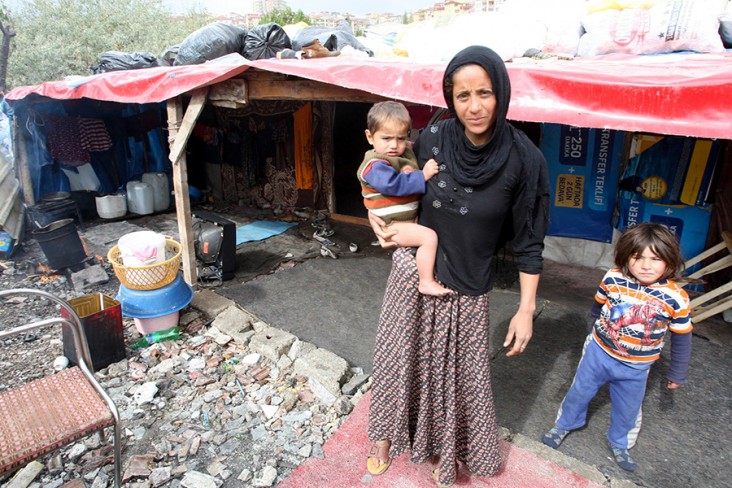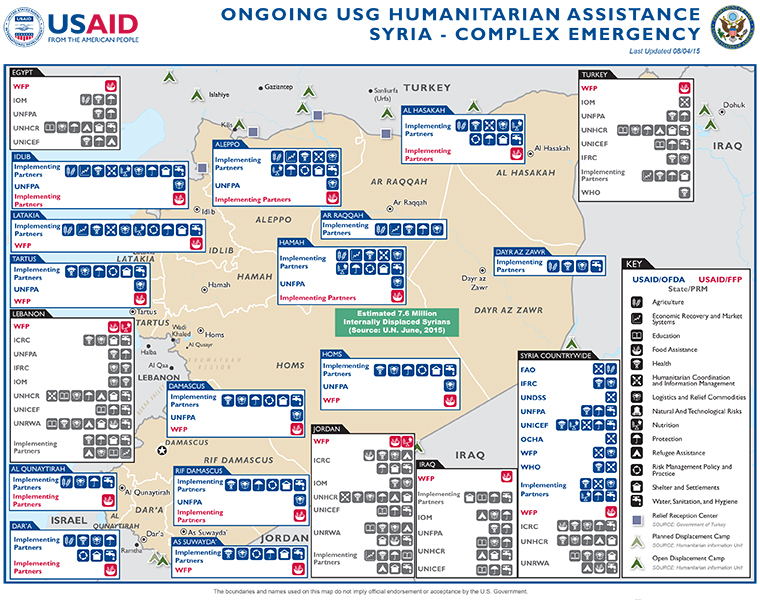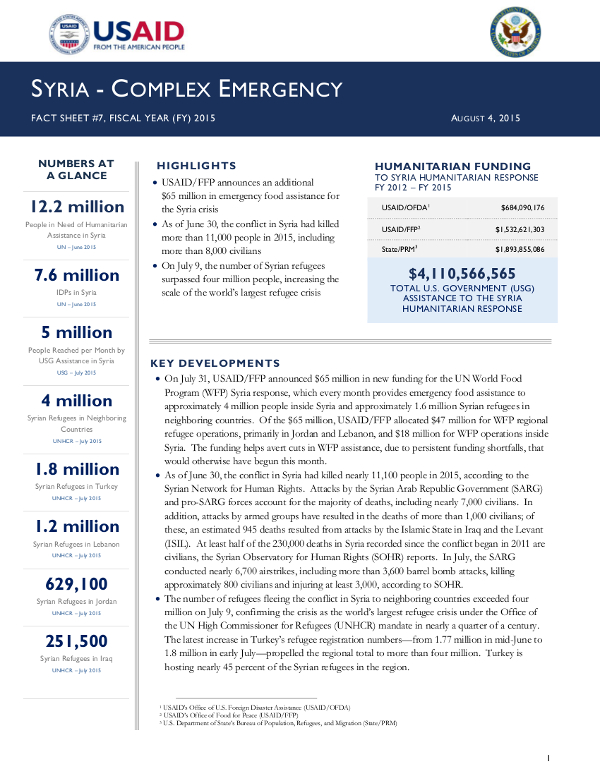September 21, 2015
Highlights
USG announces nearly $419 million in new humanitarian funding to Syria, bringing the total USG contribution to more than $4.5 billion
A human rights organization documents at least 33,000 SARG air raids, including 18,000 barrel bomb attacks, since October 2014
The UNSC unanimously adopts a resolution to create an investigative panel to hold users of chemical weapons in Syria accountable for war crimes
Key Developments
Syria Complex Emergency - Map #8 ![]() (pdf - 567k)
(pdf - 567k)
Numbers At A Glance
12.2 million
7.6 million
5 million
4.1 million
1.9 million
1.1 million
628,887
248,503
Humanitarian Funding
To Syria Humanitarian Response
FY 2012 - FY 2015
| USAID/OFDA | $866,283,433 |
| USAID/FFP | $1,550,694,720 |
| State/PRM | $2,112,085,086 |
| TOTAL | $4,529,063,219 |
Syria Complex Emergency - Fact Sheet #8 ![]() (pdf - 372k)
(pdf - 372k)
On September 21, the USG announced nearly $419 million in new humanitarian funding to support the delivery of life-saving emergency assistance to people affected by the crisis in Syria, including more than $182 million in funding from USAID/OFDA, more than $200 million from State/PRM, and approximately $18 million from USAID/FFP. Through partner organizations, USG funding will support the provision of emergency health, logistics, and water, sanitation, hygiene (WASH) support, as well as food assistance and shelter and protection activities for conflict-affected populations throughout Syria and in neighboring countries.
From October 2014 to August 2015, the Syrian Observatory for Human Rights (SOHR)—a United Kingdom-based human rights organization—documented more than 33,000 Syrian Arab Republic Government (SARG) air raids in Syria, including more than 18,000 barrel bomb attacks and more than 15,000 other aerial attacks, according to a mid-August report. During the same period, SOHR documented nearly 5,500 civilian deaths, including more than 1,100 children, and injuries to at least 30,000 civilians. Since the start of the Syrian civil war in March 2011, SOHR has documented the deaths of at least 240,000 people.
On August 7, the UN Security Council (UNSC) unanimously adopted a resolution to create an investigative panel to hold chemical weapon users accountable for war crimes in Syria. In 2013, the UNSC mandated that the SARG dismantle and destroy its chemical weapon stockpile under international supervision. While the UNSC has repeatedly condemned chemical attacks as violations of the Chemical Weapons Convention, chemical attacks on civilians continue to occur, according to the Organization for the Prohibition of Chemical Weapons (OPCW). The newly adopted resolution will establish a UN–OPCW Joint Investigative Mechanism to gather and test evidence with the aim of identifying perpetrators of chemical attacks, confronting impunity for war crimes in Syria, and preventing future abuses.
HUMANITARIAN ACCESS & POPULATION DISPLACEMENT
Of the approximately 7.6 million people displaced within Syria, an estimated 50 percent are children, according to the UN Office for the Coordination of Humanitarian Affairs (OCHA). As a result of ongoing conflict and shifting frontlines, many internally displaced persons (IDPs) have experienced multiple displacements throughout Syria since 2011. In 2015, the conflict has newly displaced as many as 1.2 million Syrians. Populations in Al Hasakah, Ar Raqqah, Aleppo, Dar’a, and Idlib governorates are among those most-affected due to indiscriminate SARG airstrikes on civilian population centers and infrastructure, as well as escalated conflict between Islamic State in Iraq and the Levant (ISIL) forces, the SARG, and multiple armed opposition groups.
As of mid-September, more than 3,000 households—an estimated 80 percent of whom are Palestinian refugees—had returned to the capital city of Damascus’ Husseinieh neighborhood, following displacement caused by armed conflict two years ago, according to the UN Relief and Works Agency for Palestine Refugees in the Near East (UNRWA). During August, the SARG began allowing civilians from Husseinieh to return, constituting the first large-scale return of Palestinian refugees within Syria. Prior to the initial displacement, approximately 6,800 households lived in Husseinieh. UNRWA is resuming services disrupted by conflict, including re-opening schools ahead of the 2015–2016 school year, and distributing basic humanitarian supplies.
Although UN agencies and non-governmental organizations (NGOs) reached millions of Syrians with humanitarian assistance in July 2015, substantial obstacles to humanitarian access remain, according to the August 27 UN Report of the Secretary-General on the Implementation of UN Security Council Resolutions (UNSCR) 2139, 2165, and 2191. Primary obstacles include deliberate access obstruction by parties to the conflict, closed border points, and administrative hurdles for humanitarian staff. An estimated 4.6 million Syrians live in UN-designated hard-to-reach areas, most of which are in ISIL-held territories. Of 127 hard-to-reach areas, UN agencies and NGOs reached only 29 during July. The report also noted armed actors’ disregard for human life and highlighted the indiscriminate use of conventional weapons by all parties, which has resulted in tens of thousands of deaths and injuries among Syrian civilians. The UN urged all parties to the conflict to respect international humanitarian law by ending the indiscriminate use of weapons of war and allowing unimpeded humanitarian access to all populations in need of life-saving assistance.
FOOD SECURITY
In late July, the Agency for Technical Cooperation and Development released findings from a March food security and livelihoods assessment that covered nearly 620 households in eastern, opposition-held areas of the city of Aleppo, Aleppo Governorate. Although most households employ multiple livelihood strategies, approximately 66 percent of respondents rely on work and business ownership as a primary source of livelihood, while an additional 22 percent rely on humanitarian assistance. An estimated 45 percent of surveyed households engage in high-risk or socially degrading employment as emergency coping mechanisms, including forcing children to beg. Having received continuous emergency food distributions for more than one year, including significant assistance from partners funded by USAID/FFP, the report found that residents of Aleppo city experience relatively low food insecurity. The assessment identified 2.5 percent of households as severely food-insecure and an additional 23 percent as marginally food-insecure. Households consistently report access to safe drinking water as a priority need.
HEALTH AND WASH
The UN Children’s Fund (UNICEF) estimates that the average availability of safe drinking water in Syria has declined by approximately 50 percent since 2011. In Aleppo and Hamah governorates, safe drinking water availability has declined by as much as 80 percent. Existing water supply systems are unable to meet daily needs due to recurrent water supply cuts; damage to power generation plants; and the systemic failure of water infrastructure due to suboptimal maintenance.
USG partner UNICEF provided water treatment supplies to ensure safe drinking water access for approximately 15 million people in Syria from January to July 2015. During the same period, UNICEF provided an estimated 5.4 million people with improved WASH services, including the rehabilitation of pipes, development of alternative safe drinking water sources, and installation of water storage tanks.
USG partner the International Organization for Migration (IOM) provided multi-sector assistance to more than 3 million people inside Syria during July, and reached more than 300,000 people in UN-designated hard-to-reach areas during the past year. IOM’s primary activities in July included shelter rehabilitation, distribution of emergency relief items, and WASH assistance—including the delivery of water purification tablets, safe drinking water, and water tanks.
In August, UNRWA confirmed a typhoid outbreak in Damascus’ Yarmouk neighborhood. As of September 11, the agency had treated approximately 70 suspected typhoid cases among civilians at a mobile health point established in Yalda—an area to the east of Yarmouk—where UNRWA medical personnel saw more than 1,750 patients in August. UNRWA medical personnel have observed cases of malnutrition and severe malnutrition among those treated at the health point, particularly among children. The agency also noted reports of a typhoid outbreak in adjacent areas, including the Babila and Beit Saham neighborhoods. The SARG authorized UNRWA to provide limited health and WASH assistance in Yalda.
HUMANITARIAN COORDINATION
In coordination with the Logistics Cluster—the coordinating body for humanitarian logistics activities, comprising UN agencies, NGOs, and other stakeholders—the UN delivered more than 1,000 truckloads of humanitarian supplies through cross-border deliveries from Jordan between April and June. Additionally, the Turkish Red Crescent Society facilitated the passage of more than 2,100 truckloads of humanitarian supplies from Turkey to Syria during the same period. UN interagency humanitarian deliveries reached affected populations in Aleppo, Dar’a, Hamah, Idlib, and Latakia governorates, providing emergency food assistance to more than 1,670,000 people; health assistance and medical supplies to nearly 1,440,000 people; household relief items to at least 171,600 people; and WASH services to more than 120,700 people.
PROTECTION
USG partner the UN Population Fund (UNFPA) and its implementing partners inside Syria provided gender-based violence and reproductive health services to conflict-affected individuals in Al Hasakah, As Suwayda’, Aleppo, Damascus, Hamah, Homs, Latakia, and Tartus governorates in July. Reproductive health services, including family planning services, benefitted nearly 15,000 women in Syria. UNFPA also supported obstetric services for nearly 500 women and provided 600 reproductive health vouchers in Aleppo, Damascus, and Rif Damascus governorates. In addition to 28 mobile clinics, 27 static clinics, and 13 medical points, UNFPA supports a recently reopened reproductive health clinic Al Hasakah.
REFUGEE ASSISTANCE
Regional
The Office of the UN High Commissioner for Refugees (UNCHR) has issued a funding appeal for the European refugee crisis, seeking $30.5 million to assist countries in Europe, including Turkey, to cope with the recent refugee influx. The appeal covers the period from June 2015 through December 2016 and aims to aid refugees crossing the Mediterranean Sea from North Africa and entering Europe via Turkey and Greece. Humanitarian assistance will range from food, relief commodities, and shelter to pre-registration, counseling, and monitoring of vulnerable persons. The UN anticipates the funding will assist 400,000 people in 2015 and 450,000 people in 2016. UNHCR estimates that more than 322,000 people—nearly half of whom are Syrian—have crossed the Mediterranean Sea to Europe in 2015.
Jordan
With USG support, UNICEF’s 2015 Child Cash Grant program assists the most vulnerable children and seeks to reduce families’ use of negative coping mechanisms that affect children, such as child labor and early marriage. In June, UNICEF provided child cash grants to more than 56,000 boys and girls from nearly 16,000 Syrian refugee families living in host communities and urban centers in Jordan. Of the children who benefit from the approximately $28 monthly grant, 76 percent are younger than 12 years of age, nearly 50 percent are girls, and 26 percent are children younger than five years of age. According to UNICEF, more than 60 percent of beneficiaries live in poverty or experience other vulnerabilities, including being separated from immediate family members or being disabled.
UNICEF’s transition to more sustainable interventions in Syrian refugee camps in Jordan is underway, with significant progress achieved during recent months. In Za’atari refugee camp, UNICEF is updating the water network by constructing storage tanks and improving the main transmission line. The upgrades, which will be operational by late 2015, will significantly reduce reliance on costly water trucking. In Azraq refugee camp, the final phase of construction is underway on a wastewater treatment plant and a water borehole project, which will greatly reduce WASH-related costs in the camp.
USAID/FFP partners have injected approximately $450 million into Jordan’s economy through the purchase and processing of various humanitarian food commodities since 2013. This figure includes sales generated from UN World Food Program (WFP) refugee operations and purchase of wheat that is milled into flour and packaged in Jordan; all revenue support local businesses.
Lebanon
Between January and June 2015, UN agencies and implementing partners provided nearly 700,000 primary health care consultations for vulnerable populations in Lebanon. Syrian refugees comprised 75 percent of the beneficiaries, followed by Palestinian refugees from Syria, and vulnerable Lebanese people. To date, more than 41,500 pregnant women have sought antenatal care, or approximately 20 percent of the annual target of the 2015 Syria Regional Refugee and Resilience Plan. The UN and implementing organizations continue to implement strategies to encourage pregnant women to seek preventive medical care.
Turkey
UNFPA distributed nearly 23,000 hygiene kits during the month of July for Syrian refugees in Turkey’s cities of Akcakale, Ankara, Batman, Kiziltepe, and Sanliurfa. In addition, UNFPA organized 12 reproductive health awareness sessions for more than 180 refugees in Ankara and Sanliurfa. UNFPA partners report, however, that hospitals in southeastern Turkey require greater assistance, as they are experiencing an influx of patients in need of emergency care.
CONTEXT
Following the commencement of peaceful demonstrations against the SARG in March 2011, President Bashar alAsad pledged legislative reforms. However, reforms failed to materialize, and SARG forces loyal to President alAsad began responding to demonstrations with violence, leading armed opposition groups to retaliate.
At a November 2012 meeting in Doha, Qatar, Syrian opposition factions formed an umbrella organization—the National Coalition for Syrian Revolutionary and Opposition Forces, also known as the Syrian Coalition (SC). The USG recognized the coalition as the legitimate representative of the Syrian people on December 11, 2012. On March 19, 2013, the SC established the Syrian Interim Government, which opposes the SARG and is based in decentralized locations throughout opposition-held areas of Syria.
The UNSC adopted UNSCR 2139 on February 22, 2014, pressing the SARG and other armed actors to allow unfettered humanitarian access for relief aid workers in Syria. The resolution identified priority areas for emergency relief aid, and the UN is releasing monthly reports tracking progress on implementing the resolution’s objectives and access gains, as well as persistent access impediments.
On July 14, 2014, the UNSC unanimously adopted UNSCR 2165, authorizing UN cross-border and cross-line delivery of humanitarian aid to conflict-affected populations without SARG approval. The resolution permits the UN’s use of four border crossings from Turkey, Jordan, and Iraq—in addition to other crossings already in use by UN agencies—for delivery of humanitarian assistance into Syria. The resolution also establishes a monitoring mechanism under the authority of UN Secretary-General Ban Ki-moon and with the consent of the neighboring countries to ensure that deliveries across these border points contain only humanitarian items.
UNRWA has registered approximately 560,000 Palestinian refugees in Syria, with more than 80 percent living in and around Damascus. Intense fighting in and around Palestinian camps and neighborhoods has significantly affected Palestinian refugees in Syria. UNRWA estimates that over 50 percent of Palestinian refugees are displaced within Syria, with a further 12 percent displaced to neighboring countries. Syria also hosts an estimated 39,500 Iraqi refugees, primarily in the greater Damascus area.
PUBLIC DONATION INFORMATION
The most effective way people can assist relief efforts is by making cash contributions to humanitarian organizations that are conducting relief operations. A list of humanitarian organizations that are accepting cash donations for disaster responses around the world can be found at www.usaid.gov/crisis/syria.
The USG encourages cash donations because they allow aid professionals to procure the exact items needed (often in the affected region); reduce the burden on scarce resources (such as transportation routes, staff time, and warehouse space); can be transferred very quickly and without transportation costs; support the economy of the disaster-stricken region; and ensure culturally, dietary, and environmentally appropriate assistance.










Comment
Make a general inquiry or suggest an improvement.